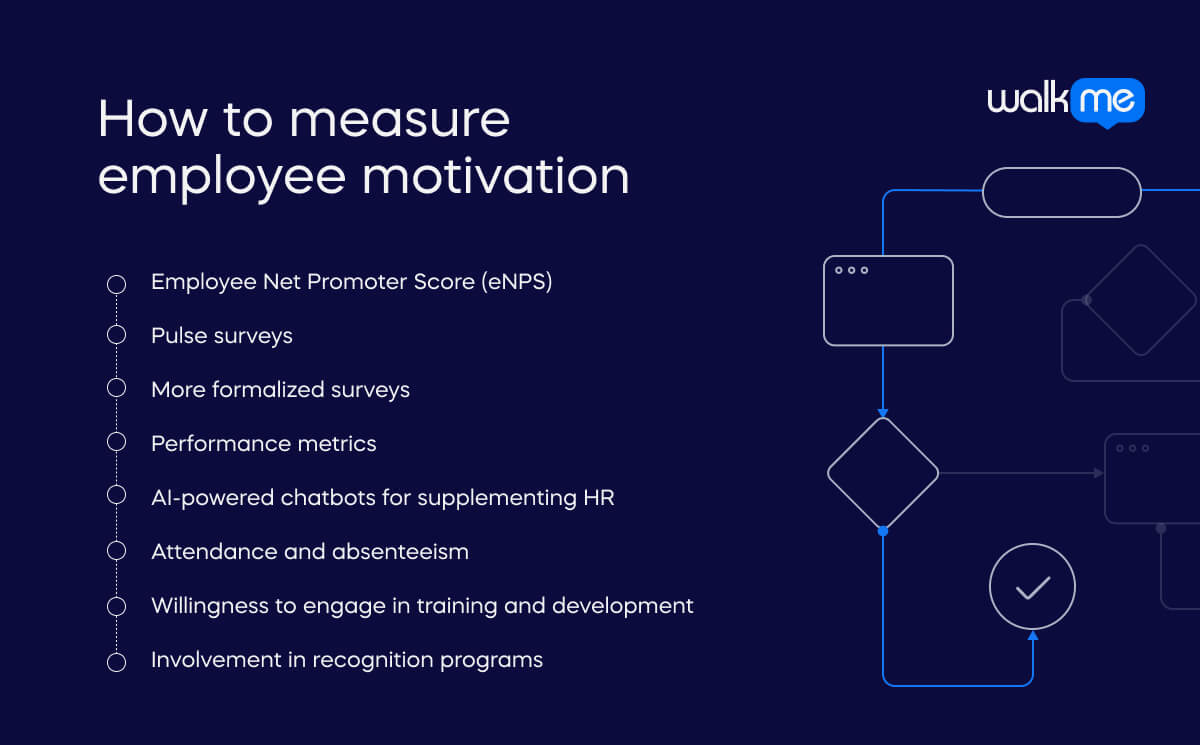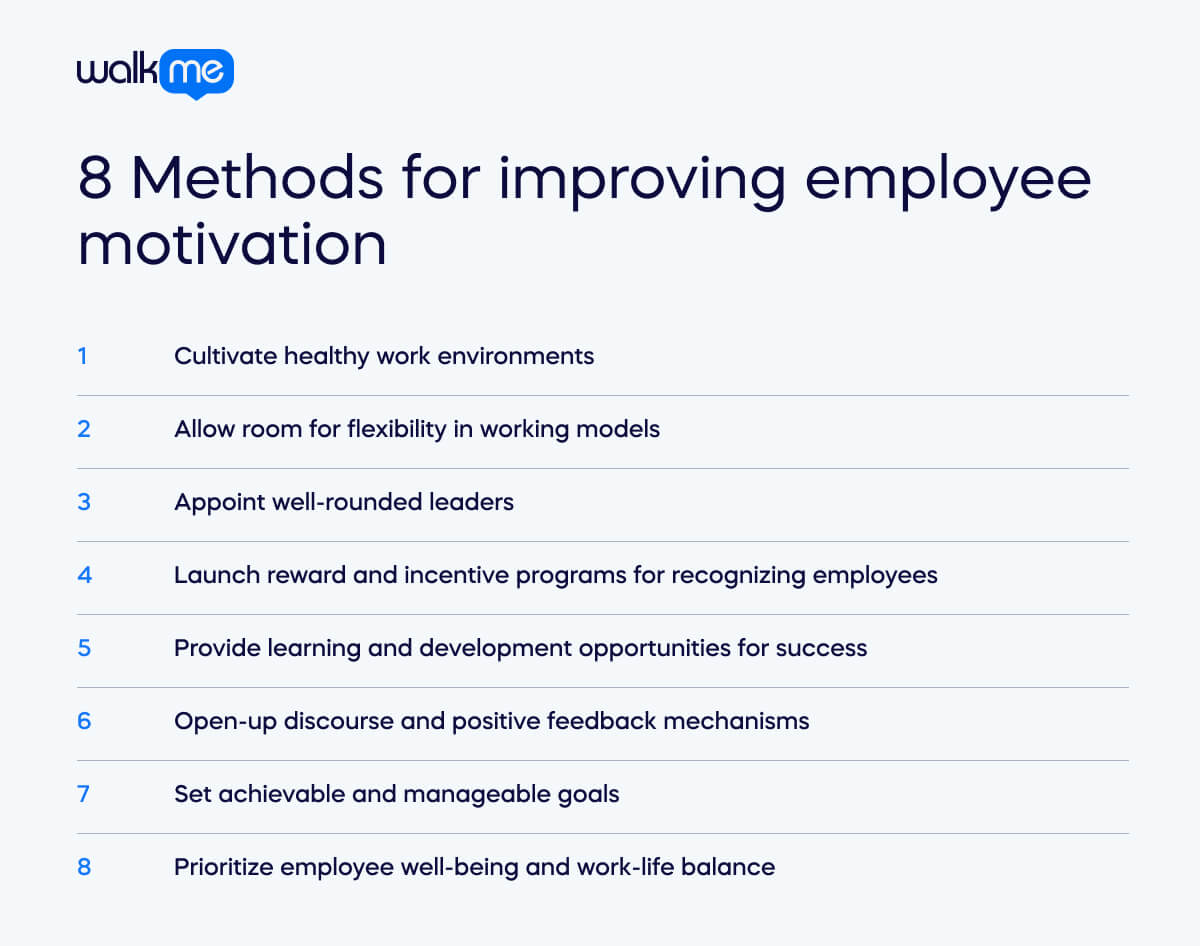Who’s likely to work harder? The employee who has the potential to earn a promotion or bonus, or the employee whose best work goes unrecognized?
The importance of employee motivation on work performance and productivity cannot be understated.
Without incentives to work harder and achieve more, employees may resort to “quiet quitting.” This is when employees gradually disengage from their roles because of feeling undervalued and overlooked. If not addressed, this can negatively impact team morale and productivity.
This article will help you understand why employee motivation matters. We’ll explore what it is, and why it’s important. We’ll also explore different types of motivation and the best ways to measure it.
What is employee motivation?
Employee motivation refers to the level of enthusiasm, ambition, and drive staff members show at work. How motivated an employee feels affects how well they do their job. This also shapes the workplace atmosphere and how quickly the company gets things done.
Motivation often overlaps with other workplace factors that can both change employee feelings and be changed by them. This includes things like employee productivity, engagement, and morale. According to research, more than 70% of employees desire their employers to take additional measures to motivate them.
Why is employee motivation important?
The importance of employee motivation cannot be overstated. How motivated people feel, both as individuals and as a team, affects everything. From how well they work to the company’s atmosphere and even how much money it makes.
Of course, organizations want to hire self-driven people with a solid work ethic. However, finding effective methods to keep motivation high is also critical. Gallup’s research explains why employees are feeling less engaged at work: “The overall decline was especially related to clarity of expectations, opportunities to learn and grow, feeling cared about, and a connection to the organization’s mission or purpose.”
A reluctance to address employee motivation only serves to stifle progress and innovation. This can quickly lead to a stagnant workforce wholly unable to adapt. Natural consequences include high staff turnover and disharmony among teams. and an inability to hit organizational goals leaves firms at risk of lagging in their respective sectors.
In the current digitally-driven climate, this is a recipe for failure. Statista said spending on digital transformation was expected to hit 1.6 trillion U.S. dollars in 2022. Looking ahead to 2026, global spending on digital transformation will be predicted to jump to 3.4 trillion U.S. dollars.
How employee motivation drives organizational success
High employee motivation acts as a catalyst for organizational agility. Motivated employees make companies more adaptable. This impacts many aspects of their work experience that benefit both the employees and the company.
The following examples show how employee motivation can positively influence workplace success:
- Elevated productivity: Motivated employees work harder and more efficiently. This boosts overall output for the company.
- Enriched job satisfaction: Happy employees create a positive work environment and are less likely to quit
- Cultivation of innovation and creativity: Motivated people are more likely to develop new ideas to help the company grow.
- Engaged workforce: Motivated employees take part more in their work. This leads to better collaboration, teamwork, and a positive company culture.
- Reduced turnover impact: When people are motivated and happy, they’re less likely to look for other jobs.
- Adaptability to change: Motivated teams are better at handling challenges and changes in the workplace.
- Positive work ethos: Employee motivation helps create a great work environment. This attracts top talent and makes the company look like a desirable place to work.
- Milestone success: Motivation helps individuals and teams work together to reach business goals.
- Customer satisfaction: Motivated employees naturally provide better customer service. This leads to happy and loyal customers likely to return.
- Workforce continuity: High motivation levels motivate employees to stay with the company. This creates a stable workforce and reduces the costs and disruptions of employee turnover.
How to measure employee motivation
It’s clear – companies need to come up with ways to boost employee motivation. They need methods to measure how motivated (or unmotivated) their workers are.
Today’s business leaders must implement strategies to address factors influencing overall employee motivation.
This includes conducting surveys, analyzing performance metrics, and ensuring open communication channels. This provides a holistic understanding of employee motivation and helps identify areas for improvement.
Let’s explore:
Employee Net Promoter Score (eNPS)
Employee net promoter score (eNPS) helps companies figure out if employees would recommend the company as a good place to work. This shows how happy people are with their jobs. Employees have to really think about their workplace satisfaction before answering. This gives the company important feedback about their overall experiences.
Pulse surveys
Pulse surveys are a less disruptive way to get feedback on employee motivation. They are short, targeted surveys that don’t take much time to complete. Companies can use them to spot trends in how employees feel. They also help understand those feelings better. These surveys are key in letting companies find areas where things can be improved.
More formalized surveys
Companies can also get employee feedback with longer, more detailed surveys instead of Pulse surveys. These surveys ask about many factors affecting motivation and let employees give more in-depth answers. Discuss career goals, challenges, and elements influencing their motivation or demotivation with staff.
Performance metrics
Companies can also look at how well employees do as a measure of motivation. Track individual and team successes and do regular performance reviews. Employees doing well are likely motivated. If performance drops, it might be a sign that motivation is low. In addition, evaluating the accomplishment of individual and team goals also provides insight. Consistently meeting or exceeding goals is often linked to high motivation.
AI-powered chatbots for supplementing HR
Organizations are utilizing AI-powered chatbots to supplement various functions typically handled by HR. These chatbots can answer many employee questions about company benefits, time off requests, and how to get started with a new job. This frees up HR staff and ensures employees quickly get the necessary information.
Attendance and absenteeism
Keeping a close eye on attendance and punctuality is valuable for assessing employee motivation. Tracking how often employees show up for work can show how engaged and motivated they feel. If attendance worsens, it could be a sign of low motivation. But if employees clock on in time and are rarely late, it might mean morale is improving.
Willingness to engage in training and development
Seeing employees’ eagerness to learn new things is a good way to measure motivation. Companies can track how many people sign up for training programs. If a lot of employees want to improve their skills, it’s a sign they’re motivated. This leads to a workforce that’s better at their jobs and can adapt to change.
Involvement in recognition programs
Companies can also see how motivated employees are by looking at how they participate in recognition programs. These programs reward good work. If a lot of employees are involved, it means they value being recognized and are likely happy with their jobs. This is a sign of a motivated workforce.
Understanding the different types of employee motivation
Before you put any motivation plans into action, it’s important to remember people get motivated in different ways. External or internal factors may motivate some people. Others, financial and social.
Let’s explore the different types of employee motivation that influence workplace productivity.
- Intrinsic motivation: Comes from within. People feel this kind of motivation when they enjoy a task, feel proud of their work, or find something personally satisfying.
- Extrinsic motivation: Derives from external factors like rewards, recognition, or avoiding punishment.
- Financial motivation: This comes from money. People are motivated by raises, bonuses, or other financial rewards.
- Social motivation: This comes from feeling connected to others. People feel motivated when they get recognition, feel like part of the team, and have positive interactions at work.
- Achievement motivation: This is about reaching goals. People feel motivated when they’re working towards something that matters to them.
8 Methods for improving employee motivation
Below, we explore various methods for cultivating employee motivation for today’s workforce.
Focusing on employee motivation is essential for companies to be adaptable, handle challenges, and come up with new ideas.
Motivated employees drive better productivity and customer service. This is especially important in competitive industries. High motivation can be the difference between getting ahead of the competition or falling behind.
Gallup research finds that managers significantly impact engagement levels—up to 70%. The study found that employees are more engaged when their managers help them build on their strengths and communicate with them regularly.
-
Cultivate healthy work environments
Employees need to feel like they’re part of the team and that their work matters. This means companies need a strong culture. A good work culture makes employees feel like they belong and understand the company’s goals. It also encourages open communication, respect, and teamwork. This is the type of environment where people come up with new ideas and work hard to improve.
-
Allow room for flexibility in working models
Giving employees more flexibility, freedom, and choices about their work can boost motivation. This could mean letting them set their own hours, work from home, or choose a mix of office and remote work.
However, it’s important to have security measures in place for remote work. This protects against risks that could compromise company data. This mitigates the use of unsanctioned devices or instances of shadow IT. Purplesec research found that over 4.2 million American mobile users suffered ransomware attacks on their phones.
-
Appoint well-rounded leaders
As we know, managerial input directly correlates with high employee motivation. When choosing managers and leaders, look for people who are good at supporting different kinds of employees.
Managers should have good communication and be able to work across teams. This includes resolving disagreements and supporting programs that help employees learn and grow.
These skills are essential for creating a positive work environment and the growth and motivation of team members. Leaders should also demonstrate empathy, integrity, and a genuine interest in their employees’ well-being and professional development.
-
Launch reward and incentive programs for recognizing employees
Studies don’t always agree on whether giving employees more money makes them more motivated. Still, it’s important to remember that there are rewards beyond just money. It’s important to find the ones that work best for your team.
People get motivated by different things. Some might like a bonus, but others might want more flexibility, time off, a promotion, or even just a “thank you.” The key is ensuring employees feel valued when you have reward programs.
-
Provide learning and development opportunities for success
Giving employees opportunities to learn and develop is a great way to keep them motivated and engaged. Employees with access to ongoing training and skill development programs feel valued and empowered to grow.
HR leaders should create learning programs that benefit employees’ career prospects. Companies with strong learning cultures tend to have more engaged and successful employees. Offering opportunities to learn and grow helps businesses attract the best people – and keep them.
-
Open-up discourse and positive feedback mechanisms
Employees need to feel comfortable sharing their thoughts and getting feedback. Those who feel heard and valued are more likely to be motivated. As such, HR leaders should set up ways for employees to share their ideas, opinions, and concerns.
Regular feedback helps everyone improve and identifies areas for growth. Companies with strong feedback cultures have happier employees who stay with the company longer.
Businesses can boost employee morale and be more successful by creating a culture where everyone feels valued. This includes setting up systems where employees are supported and can communicate openly.
-
Set achievable and manageable goals
Having goals helps employees work more efficiently and feel more engaged. Goal-setting gives clear direction and makes it easier to stay productive. Setting smaller, achievable goals helps employees see how their work contributes to the company’s bigger goals. It also lets them know the steps they need to take to succeed, like working towards a promotion.
Reaching goals can really boost motivation. It also helps ensure individual and team efforts support the company’s overall success.
-
Prioritize employee well-being and work-life balance
Evolving employee expectations requires extra emphasis on personal well-being and a work-life balance. In 2022, the “Great Resignation” gained momentum. Research shows that approximately 50.5 million people quit their jobs, surpassing the previous record set in 2021.
Employees are increasingly focused on their personal well-being and want a good work-life balance. This shows that they care about more than just getting ahead in their careers.
Employers need to rethink their policies to match these changing expectations. This means offering things like flexible work options, mental health support, and programs that promote a healthy work-life balance.
Employee motivation: A key lever for organizational agility
The importance of employee motivation to the overall success of your business is huge. Statistics show that a mere 15% of employees worldwide report feeling motivated. However, when done right, companies that highly value employees can increase revenue by 682%.
Cultivating a truly motivated workforce requires a collaborative effort from business leaders. Efforts are required from HR professionals, management teams, stakeholders, and, most importantly, employees. This creates a culture where employees are active participants and promoters of an agile workforce.
This means giving employees more control over their work and encouraging them to come up with new ideas. It’s about making them feel like their work matters to the company.
When employees are involved in decisions, given chances to grow, and recognized for their work, it creates a positive workplace. This ultimately helps everyone feel valued and motivated to excel.



